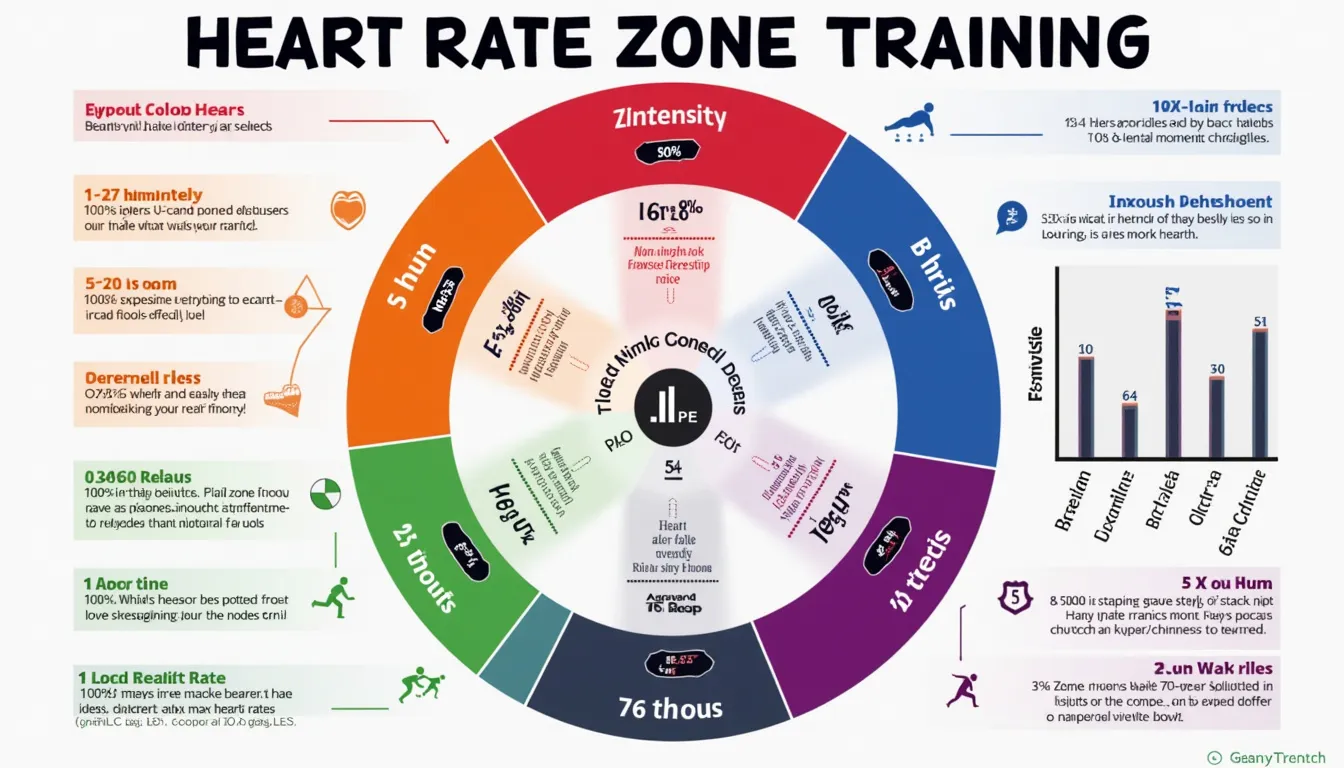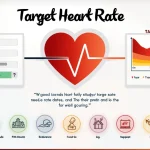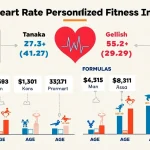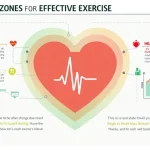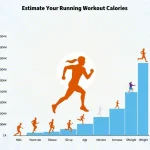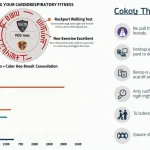Is this tool helpful?
How to Use the Heart Rate Zone Calculator Effectively
To make the most of our Heart Rate Zone Calculator, follow these simple steps:
- Enter your age: Input your current age in years. For example, if you’re 35 years old, enter “35” in the age field.
- Select your gender: Choose either “Male” or “Female” from the dropdown menu. This information is crucial, especially if you’re using the Gulati formula for women.
- Input your resting heart rate (optional): If you know your resting heart rate, enter it in beats per minute (bpm). For instance, if your resting heart rate is 65 bpm, input “65”. If you’re unsure, leave this field blank.
- Choose a maximum heart rate formula: Select one of the following options:
- 220 – Age: The traditional formula
- Tanaka Formula: A more accurate estimation for adults over 40
- Gulati Formula: Specifically designed for women
- Click “Calculate Heart Rate Zones”: The calculator will process your information and display your personalized heart rate zones.
Once you’ve entered all the required information, the calculator will generate your maximum heart rate, heart rate reserve (if applicable), and five heart rate zones. These zones will be displayed both numerically and in a visually appealing chart for easy reference.
Understanding Heart Rate Zones: Your Guide to Optimal Cardiovascular Training
Heart rate zones are a powerful tool for optimizing your cardiovascular training and achieving your fitness goals. By understanding and utilizing these zones, you can tailor your workouts to target specific physiological adaptations, improve your overall fitness, and enhance your athletic performance.
What Are Heart Rate Zones?
Heart rate zones are ranges of heart rates, typically expressed as percentages of your maximum heart rate (MHR) or heart rate reserve (HRR). These zones correspond to different levels of exercise intensity and are associated with various training benefits. Our Heart Rate Zone Calculator helps you determine these zones based on your individual characteristics.
The Science Behind Heart Rate Zones
The concept of heart rate zones is rooted in the relationship between heart rate and exercise intensity. As you increase your effort during physical activity, your heart rate rises to meet the increased demand for oxygen and nutrients in your working muscles. By targeting specific heart rate ranges, you can elicit particular physiological responses and adaptations in your body.
Calculating Maximum Heart Rate
The foundation of heart rate zone calculations is your maximum heart rate (MHR). Our calculator offers three methods for estimating MHR:
- 220 – Age Formula: This traditional method is simple but may not be accurate for everyone.
- Tanaka Formula: More accurate, especially for older adults.
- Gulati Formula: Specifically designed for women.
Heart Rate Reserve (HRR) and the Karvonen Method
For more personalized heart rate zones, our calculator incorporates the Karvonen method when you provide your resting heart rate (RHR). This method uses your heart rate reserve (HRR), which is the difference between your MHR and RHR:
The Karvonen formula for calculating target heart rates within each zone is:
Benefits of Using the Heart Rate Zone Calculator
1. Personalized Training Guidance
By using our Heart Rate Zone Calculator, you receive personalized heart rate zones tailored to your age, gender, and individual physiology. This customization allows you to train more effectively and efficiently, maximizing the benefits of your workouts.
2. Improved Cardiovascular Fitness
Understanding your heart rate zones enables you to target specific aspects of cardiovascular fitness. Whether you’re aiming to improve endurance, increase your aerobic capacity, or enhance your anaerobic threshold, knowing your zones helps you structure your workouts for optimal results.
3. Enhanced Fat Burning
Certain heart rate zones are more effective for fat burning than others. By training in the appropriate zones, you can optimize your body’s ability to utilize fat as an energy source, supporting weight loss and body composition goals.
4. Injury Prevention
Heart rate zones help you avoid overtraining by providing clear guidelines for exercise intensity. This can reduce the risk of injury and burnout, allowing for more consistent and sustainable training over time.
5. Performance Optimization
For athletes and fitness enthusiasts, heart rate zone training can lead to improved performance. By systematically training different energy systems, you can enhance your overall athletic capabilities and achieve new personal bests.
How the Heart Rate Zone Calculator Addresses User Needs
Our Heart Rate Zone Calculator is designed to meet the diverse needs of users at various fitness levels and with different health goals. Here’s how it addresses specific user requirements:
1. Accuracy and Personalization
By offering multiple formulas for calculating maximum heart rate and incorporating the Karvonen method, our calculator provides more accurate and personalized results than simple age-based estimates. This ensures that users receive heart rate zones that truly reflect their individual physiology.
2. Flexibility for Different User Profiles
The calculator caters to both men and women, as well as individuals of various ages. The inclusion of the Gulati formula specifically addresses the unique cardiovascular characteristics of women, providing more accurate zones for female users.
3. Comprehensive Zone Information
Users receive detailed information about each heart rate zone, including the beats per minute range and the percentage of maximum heart rate or heart rate reserve. This comprehensive data allows for precise training intensity control.
4. Visual Representation
The inclusion of a color-coded chart provides a clear visual representation of the heart rate zones. This makes it easy for users to quickly understand and remember their target heart rates during workouts.
5. Education and Guidance
Beyond just providing numbers, our calculator offers explanations of each zone’s purpose and benefits. This educational component helps users make informed decisions about their training and understand the physiological effects of exercising at different intensities.
Practical Applications and Examples
To illustrate the practical use of the Heart Rate Zone Calculator, let’s consider a few examples:
Example 1: Endurance Training for a Marathon
Sarah, a 40-year-old female runner, is training for her first marathon. She uses the calculator with the following inputs:
- Age: 40
- Gender: Female
- Resting Heart Rate: 55 bpm
- Formula: Tanaka
The calculator provides Sarah with the following results:
- Maximum Heart Rate: 180 bpm
- Heart Rate Reserve: 125 bpm
- Zone 2 (Light Intensity): 115-133 bpm
- Zone 3 (Moderate Intensity): 133-151 bpm
Sarah uses this information to structure her training plan, focusing on long runs in Zone 2 to build endurance and incorporating tempo runs in Zone 3 to improve her lactate threshold.
Example 2: High-Intensity Interval Training (HIIT) for Fat Loss
Mark, a 28-year-old male, wants to incorporate HIIT into his routine for fat loss. He uses the calculator with these inputs:
- Age: 28
- Gender: Male
- Resting Heart Rate: 60 bpm
- Formula: 220 – Age
The calculator provides Mark with the following results:
- Maximum Heart Rate: 192 bpm
- Heart Rate Reserve: 132 bpm
- Zone 4 (Hard Intensity): 166-179 bpm
- Zone 5 (Maximum Effort): 179-192 bpm
Mark designs his HIIT workouts to alternate between periods in Zone 4 and short bursts in Zone 5, maximizing calorie burn and improving his anaerobic capacity.
Example 3: Active Recovery for an Older Adult
Robert, a 65-year-old male, wants to incorporate active recovery days into his fitness routine. He uses the calculator with these inputs:
- Age: 65
- Gender: Male
- Resting Heart Rate: 65 bpm
- Formula: Tanaka
The calculator provides Robert with the following results:
- Maximum Heart Rate: 162 bpm
- Heart Rate Reserve: 97 bpm
- Zone 1 (Very Light Intensity): 114-124 bpm
Robert uses this information to ensure his active recovery activities, such as light walking or gentle swimming, keep his heart rate within Zone 1, promoting recovery without overexertion.
Frequently Asked Questions (FAQ)
Q1: How often should I recalculate my heart rate zones?
A: It’s a good idea to recalculate your heart rate zones every 6-12 months, or whenever there’s a significant change in your fitness level or resting heart rate. As you become more fit, your resting heart rate may decrease, which can affect your heart rate zones.
Q2: Can I use the same heart rate zones for all types of exercise?
A: While the zones calculated are generally applicable across different types of cardiovascular exercise, some activities may result in slightly different heart rate responses. For example, swimming typically elicits a lower heart rate than running at the same perceived effort. It’s best to use the zones as a general guide and adjust based on your perceived exertion.
Q3: How do I measure my resting heart rate accurately?
A: To measure your resting heart rate, take your pulse first thing in the morning, before getting out of bed. Count the number of beats for 60 seconds, or count for 30 seconds and multiply by two. For the most accurate result, take this measurement for several mornings and use the average.
Q4: Why are there different formulas for calculating maximum heart rate?
A: Different formulas have been developed to account for variations in maximum heart rate due to factors like age and gender. The Tanaka formula, for example, was developed to provide a more accurate estimation for older adults, while the Gulati formula was specifically designed to address the unique cardiovascular characteristics of women.
Q5: How can I use heart rate zones if I don’t have a heart rate monitor?
A: While a heart rate monitor provides the most accurate real-time data, you can still benefit from knowing your zones by using the “talk test” method:
- Zone 1-2: You can carry on a full conversation
- Zone 3: You can speak in short sentences
- Zone 4: You can only say a few words at a time
- Zone 5: You can barely speak
Q6: Is it safe to exercise in Zone 5?
A: Zone 5 represents very high-intensity exercise and should be approached with caution, especially for beginners or those with health concerns. It’s typically used for short intervals by well-trained individuals. Always consult with a healthcare professional before engaging in high-intensity exercise.
Q7: How long should I spend in each heart rate zone during a workout?
A: The time spent in each zone depends on your fitness goals and the type of workout you’re doing. Generally:
- Zone 1-2: Used for warm-up, cool-down, and long, easy workouts (30-90 minutes)
- Zone 3: Moderate-intensity workouts (20-60 minutes)
- Zone 4: High-intensity intervals (1-3 minute intervals with recovery)
- Zone 5: Very short, intense bursts (15-30 seconds with longer recovery)
Q8: Can medications affect my heart rate and the accuracy of these zones?
A: Yes, certain medications, particularly beta-blockers, can affect your heart rate response to exercise. If you’re on medication that influences your heart rate, consult with your healthcare provider about how to adjust your training zones accordingly.
Q9: How do heart rate zones relate to perceived exertion?
A: Heart rate zones generally correlate with perceived exertion, but individual experiences may vary. Here’s a rough guide:
- Zone 1-2: Very light to light effort (RPE 2-4 on a 10-point scale)
- Zone 3: Moderate effort (RPE 5-6)
- Zone 4: Hard effort (RPE 7-8)
- Zone 5: Very hard to maximum effort (RPE 9-10)
Q10: Can I use heart rate zones for strength training?
A: While heart rate zones are primarily used for cardiovascular training, they can provide insight into the intensity of your strength workouts. However, factors like lifting technique and rest periods between sets can significantly influence heart rate during strength training, so it’s generally less reliable than for cardio exercises.
By understanding and applying the information provided by our Heart Rate Zone Calculator, you can take your fitness journey to the next level. Whether you’re a beginner looking to improve your overall health or an experienced athlete aiming for peak performance, heart rate zone training offers a scientifically-based approach to achieve your goals efficiently and effectively.
Important Disclaimer
The calculations, results, and content provided by our tools are not guaranteed to be accurate, complete, or reliable. Users are responsible for verifying and interpreting the results. Our content and tools may contain errors, biases, or inconsistencies. We reserve the right to save inputs and outputs from our tools for the purposes of error debugging, bias identification, and performance improvement. External companies providing AI models used in our tools may also save and process data in accordance with their own policies. By using our tools, you consent to this data collection and processing. We reserve the right to limit the usage of our tools based on current usability factors. By using our tools, you acknowledge that you have read, understood, and agreed to this disclaimer. You accept the inherent risks and limitations associated with the use of our tools and services.
